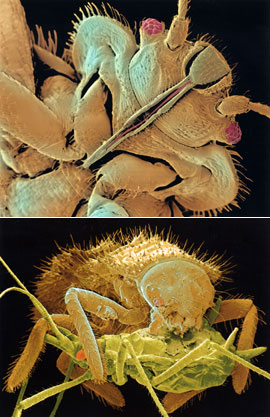Buzz
Air Date: Week of October 29, 2004
Josie Glausiusz, author of "Buzz, the Intimate Bond between Humans and Insects," tells all you need to know about one of our most intimate insect partners – bedbugs.
Transcript
CURWOOD: Insects are everywhere – they can drive us crazy, make us sick, feed us, feed on us and help us in ways we’re often unaware of. This week, we’re kicking off what will be an occasional series about these tiny creatures by author Josie Glausiusz. Today, she chronicles the intimate connection between humans and bedbugs.
GLAUSIUSZ: The bed bug is a strange and persistent bedfellow. Its been sleeping with us since we first started dwelling in caves.
At least twelve species of these blood suckers are parasites of bats, and many others feed on cave-nesting birds. Their descendents, probably realizing that humans are edible, too, followed us to our homes, hiding by day in the walls of houses, or inside bedding, and emerging by night.
According to a 14th century dictionary of the life of animals, the creature was said to have "its origin in warm blood, and an extravagant fondness for humans." This book of beastly lore may have been mistaken about the bug's origin, but it was accurate about its love for blood. It needs this nourishment to molt from nymph to adult. Though it doesn't transmit disease, it is extremely annoying, as its saliva triggers large, itchy bumps on the skin; and excessive biting can cause anemia in infants.
 Top: The common bed bug. Bottom: A seven-spotted ladybug larva eats an aphid. (Photos: Volker Steger © “Buzz: The Intimate Bond Between Humans and Insects”)
Top: The common bed bug. Bottom: A seven-spotted ladybug larva eats an aphid. (Photos: Volker Steger © “Buzz: The Intimate Bond Between Humans and Insects”)
The bed bug was once used as a remedy for snakebites. The ancients said, "Seven bed bugs mingled with water were a dose for a man, while four were sufficient for children, and the smell of them will relieve 'hysterical suffocation.'"
CURWOOD: Josie Glausiusz is author of “Buzz: the Intimate Bond Between Humans and Insects.” To see electron microscope photographs of the bedbug and other arthropods, go to our web site, Living on Earth dot org. That's Living on Earth dot o-r-g.
[MUSIC: Jonathan Richman & the Modern Lovers “Hey There Little Insect” JONATHAN RICHMAN & THE MODERN LOVERS (Castle – 2004)]
Living on Earth wants to hear from you!
Living on Earth
62 Calef Highway, Suite 212
Lee, NH 03861
Telephone: 617-287-4121
E-mail: comments@loe.org
Newsletter [Click here]
Donate to Living on Earth!
Living on Earth is an independent media program and relies entirely on contributions from listeners and institutions supporting public service. Please donate now to preserve an independent environmental voice.
NewsletterLiving on Earth offers a weekly delivery of the show's rundown to your mailbox. Sign up for our newsletter today!
 Sailors For The Sea: Be the change you want to sea.
Sailors For The Sea: Be the change you want to sea.
 The Grantham Foundation for the Protection of the Environment: Committed to protecting and improving the health of the global environment.
The Grantham Foundation for the Protection of the Environment: Committed to protecting and improving the health of the global environment.
 Contribute to Living on Earth and receive, as our gift to you, an archival print of one of Mark Seth Lender's extraordinary wildlife photographs. Follow the link to see Mark's current collection of photographs.
Contribute to Living on Earth and receive, as our gift to you, an archival print of one of Mark Seth Lender's extraordinary wildlife photographs. Follow the link to see Mark's current collection of photographs.
 Buy a signed copy of Mark Seth Lender's book Smeagull the Seagull & support Living on Earth
Buy a signed copy of Mark Seth Lender's book Smeagull the Seagull & support Living on Earth

